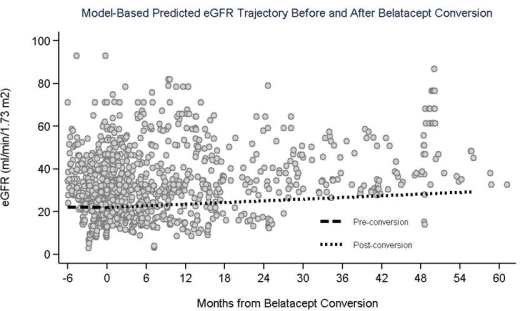Late Conversion from Calcineurin Inhibitors to Belatacept is Associated with a Sustained Improvement in Kidney Allograft Function
Medicine/Nephrology, Cedars Sinai Medical Center, Los Angeles, CA.
Meeting: 2018 American Transplant Congress
Abstract number: C69
Keywords: Co-stimulation, Immunosuppression, Kidney transplantation, Renal dysfunction
Session Information
Session Name: Poster Session C: Kidney Immunosuppression: Novel Regimens and Drug Minimization
Session Type: Poster Session
Date: Monday, June 4, 2018
Session Time: 6:00pm-7:00pm
 Presentation Time: 6:00pm-7:00pm
Presentation Time: 6:00pm-7:00pm
Location: Hall 4EF
Introduction: Belatacept was shown to have longer kidney graft survival and higher eGFR at 7 years than a calcineurin inhibitor (CNI)-based regimen in the BENEFIT trial. We examined whether conversion to belatacept from CNI among patients with graft dysfunction late post-transplant would lead to improved eGFR.
Methods: Since 2012, 53 patients maintained on CNI at least 1 year post-transplant were converted to belatacept. Of these, 48 (90.6%) converted because of graft dysfunction/CNI toxicity and 5 because of side effects (9.4%). Estimated GFR up to 6 months before conversion for patients 1-2 years post-transplant and up to 12 months pre-conversion for those ≥2 years after transplant were assessed. Post-conversion eGFR was evaluated up to 11/3/17. Pre- and post-conversion eGFR slopes were compared using a linear mixed effects model with random slopes and intercepts incorporating a linear spline with knot at belatacept conversion, adjusting for reason for conversion (side effects vs. graft dysfunction), eGFR at conversion (<30 vs. ≥30 ml/min/1.73 m2), and donor type (living vs. deceased).
Results: Patients were converted at a median 1644 days post-transplant (IQR: 841, 3668). The median eGFR at conversion was 33 ml/min/1.73 m2 (IQR: 25, 44). Three patients (5.7%) developed rejection (2 cell-mediated, 1 antibody-mediated) 48-124 days after conversion. Seven patients experienced graft failure (median 217 days post-conversion; IQR: 118, 441) and three died (median 131 days post-conversion; IQR: 44, 1073). After adjustment for other confounders, there was a slight decline in eGFR pre-conversion (slope: -0.01 ml/min/1.73 m2/month; 95% CI: -0.38-0.36); post-conversion, eGFR trajectory shifted to a positive slope (0.13 ml/min/1.73 m2/month; 95% CI: 0.08-0.19) (fig. 1).
Conclusions: Among patients at least 1 year post-transplant with graft dysfunction, belatacept conversion from CNI was associated with improved graft function up to 5 years post-conversion. CNI withdrawal late post-transplant with conversion to belatacept is associated with sustained improvement in graft function.
CITATION INFORMATION: Sethi S., Choi J., Vo A., Najjar R., Peng A., Jordan S., Huang E. Late Conversion from Calcineurin Inhibitors to Belatacept is Associated with a Sustained Improvement in Kidney Allograft Function Am J Transplant. 2017;17 (suppl 3).
To cite this abstract in AMA style:
Sethi S, Choi J, Vo A, Najjar R, Peng A, Jordan S, Huang E. Late Conversion from Calcineurin Inhibitors to Belatacept is Associated with a Sustained Improvement in Kidney Allograft Function [abstract]. https://atcmeetingabstracts.com/abstract/late-conversion-from-calcineurin-inhibitors-to-belatacept-is-associated-with-a-sustained-improvement-in-kidney-allograft-function/. Accessed January 4, 2026.« Back to 2018 American Transplant Congress

